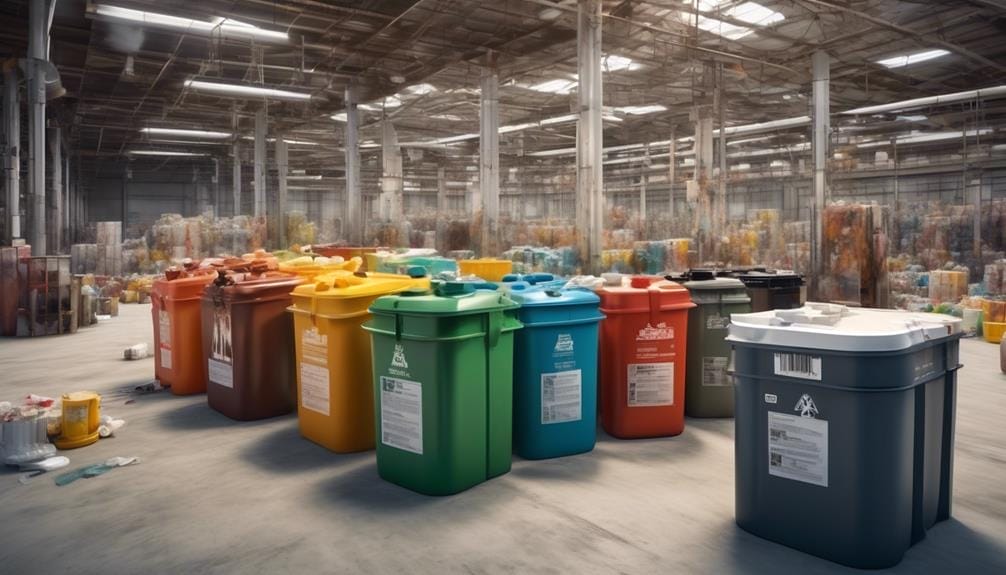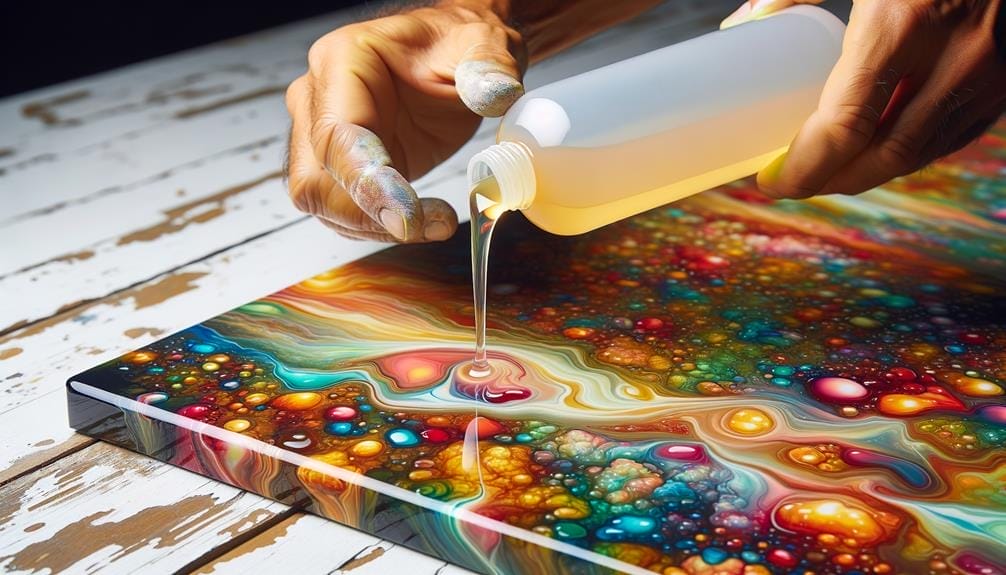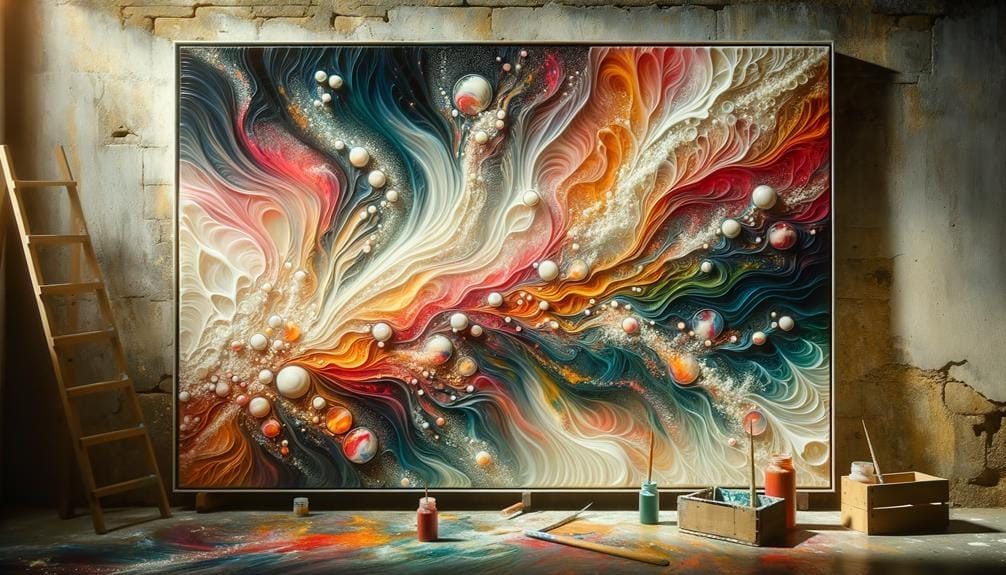Have you ever wondered about the environmental impact of art resin? Is it true that this popular material used in artistic projects has a significant effect on our environment?
Well, the truth is, art resin does indeed have a notable environmental impact, primarily due to its petroleum-based composition. But that's not all – there are other factors to consider, such as the disposal methods and challenges associated with art resin, as well as the availability of more eco-friendly alternatives.
So, let's explore the various aspects of the environmental impact of art resin and discover ways in which we can minimize its negative effects.
Key Takeaways
- Art resin, made from epoxy derived from fossil fuels, has a significant environmental impact due to the greenhouse gas emissions and pollution associated with its production.
- Disposal of unused or excess art resin should be done responsibly to prevent environmental harm, such as entering water supplies.
- Choosing art resin made from sustainable materials or exploring eco-friendly alternatives, such as bio-based or water-based resins, can help minimize the environmental impact.
- Exploring alternative materials for art projects, like hard plaster or concrete, can provide sustainable options with unique textures and finishes while reducing harm to the environment.
Production Process of Art Resin
The production process of art resin involves carefully measuring and mixing liquid resin and hardener in specific ratios to achieve the desired consistency and curing properties. Art resin is typically made from epoxy, a synthetic resin that's commonly used in various applications. Epoxy resin is made by combining two main components: the resin itself and a hardener. These components are mixed together in the correct proportions to ensure that the resin cures properly and forms a strong, durable coating.
However, it's important to consider the environmental impact of art resin production. The production of epoxy resin requires the use of chemicals derived from fossil fuels, which contribute to greenhouse gas emissions and environmental pollution. Additionally, the disposal of unused or excess resin can lead to further environmental harm.
In light of these concerns, there's a growing demand for more environmentally friendly and sustainable alternatives to traditional art resin. Some companies are now developing resin products that are made from bio-based materials, such as plant oils or recycled materials. These sustainable alternatives aim to reduce the reliance on fossil fuels and minimize the environmental impact of resin art production.
Usage of Art Resin in Artistic Projects
When using art resin in artistic projects, it is important to understand its environmental impact and make conscious choices to minimize harm. Art resin, often made from petroleum, contributes to environmental issues related to extraction and pollution. However, once cured, art resin becomes chemically inactive and does not emit anything in the air, reducing its environmental impact post-application. To further minimize the environmental impact of art resin, proper disposal is crucial to prevent it from entering water supplies and causing harm to the environment. Additionally, recycling and reusing extra art resin and hardener can help minimize waste and environmental impact.
To help you make informed decisions when using art resin, here is a table comparing different types of resins and their environmental characteristics:
| Resin Type | Environmental Impact | Sustainable Solutions |
|---|---|---|
| Epoxy Resin | Made from non-renewable resources and can be hazardous to your health if not handled properly. | Look for epoxy resins that are biodegradable and recyclable to reduce environmental impact. |
| Synthetic Resin | Made from synthetic materials, contributing to pollution and resource depletion. | Consider using natural resins, such as plant-based resins, which are more environmentally friendly. |
| Other Resins | Each resin type has its own environmental impact, so research and choose resins that are biodegradable and recyclable. | Explore sustainable alternatives like water-based resins that have a lower environmental impact. |
Disposal Methods and Challenges of Art Resin

To properly dispose of art resin, it's important to follow specific guidelines and consider the challenges associated with its disposal. Here are some key points to keep in mind:
- Storing extra resin and hardener together is crucial to prevent leakage and ensure safe disposal.
- Disposing of any excess art resin should be done at a local dump with designated chemical pits, rather than pouring it into the water supply.
- Responsible disposal at a local dump involves burning and filtering chemicals to prevent vapor leaching into the air.
- Recycling and reusing art resin can help minimize waste and environmental impact. Contact local dump sites to learn about their recycling and reusing efforts.
- Understanding the properties of different resin types is essential for minimizing environmental impact. Non-reactive resins should be handled with caution to prevent leaching.
Disposing of art resin properly is vital to protect the environment from its potential harm. It's essential to avoid pouring it into water sources, as the chemicals can leach into the water and have a negative impact on aquatic life. Burning and filtering the chemicals at local dump sites can help minimize their release into the air. Additionally, recycling and reusing art resin can significantly reduce its environmental footprint. By contacting local dump sites, you can learn about their recycling and reusing efforts and contribute to a more sustainable option. Understanding the properties of different resin types is crucial for ensuring safe disposal practices. Non-reactive resins must be handled with caution to prevent any potential leaching and environmental damage. By following proper disposal methods and exploring alternative uses or repurposing options for resin products, you can minimize the environmental impact of art resin.
Comparison of Environmental Impacts of Different Types of Art Resin
What are the environmental impacts of different types of art resin? The environmental impacts of different types of art resin vary depending on the materials used in their production. Here is a comparison of the environmental impacts of five common types of art resin:
| Resin Type | Environmental Impact |
|---|---|
| Epoxy Resin | Made from petroleum, epoxy resin causes environmental problems through pollution of oceans, water sources, soil, and air during extraction. However, once cured, epoxy resin becomes chemically inactive and does not emit anything in the air, making it a safer option after the curing process. |
| Natural Resin | Natural resins, such as those derived from trees, have a lower environmental impact compared to synthetic resins. They are a more sustainable option as they are derived from renewable sources and do not require fossil fuels for production. However, the collection of natural resins can have an impact on the ecosystem if not done sustainably. |
| Polyester Resin | Polyester resin is derived from petroleum-based chemicals, contributing to pollution and depletion of fossil fuels. It is not considered an environmentally friendly option. |
| Polyurethane Resin | Polyurethane resin is also derived from petroleum-based chemicals and has similar environmental impacts to polyester resin. It is not a sustainable choice for art resin. |
| Synthetic Resin | Synthetic resins are created using chemical processes and often involve the use of fossil fuels. Their production contributes to environmental pollution and the depletion of natural resources. |
When choosing art resin, it is important to consider the environmental impact of the materials used and opt for more sustainable options whenever possible.
Eco-Friendly Alternatives to Art Resin

Consider incorporating eco-friendly alternatives to art resin for a more sustainable approach to your artistic projects. Here are five options to explore:
- Ecopoxy: This bio-based epoxy resin is made from renewable resources, offering a sustainable option for your artwork.
- Water-based resins: These safer alternatives to solvent-based resins significantly reduce their environmental impact, making them a more eco-friendly choice.
- Natural resins: Derived from sustainable sources, these resins provide an environmentally friendly option for your art projects.
- Terra Cast resin: This brand offers sustainable options with colors made from 100% post-consumer recycled materials, allowing you to create beautiful pieces while minimizing waste.
- Alternative materials: Consider using hard plaster, concrete, alabaster, slush latex, or metal for eco-friendly art projects. These materials are more sustainable and can offer unique textures and finishes.
Frequently Asked Questions
Is Resin Art Environmentally Friendly?
Resin art can be environmentally friendly when artists choose sustainable alternatives, practice resin recycling, and use renewable materials. By reducing their carbon footprint, adopting biodegradable options, and following green art practices, eco-conscious artists contribute to a more eco-friendly resin production.
What Impact Does Resin Have on the Environment?
Resin has a significant impact on the environment, but there are ways to minimize it. Consider recycling options, sustainable alternatives, proper resin disposal, reducing carbon footprint, eco-friendly practices, environmental regulations, renewable materials, pollution prevention, water conservation, and green certifications.
Is Artresin Hazardous?
Artresin is not hazardous, but it's important to take safety precautions. Proper ventilation is crucial. Disposing of artresin properly, by storing and reusing or disposing at a designated chemical pit, helps minimize environmental impact.
Can You Get Environmentally Friendly Resin?
You can definitely find environmentally friendly resin options. There are eco-friendly alternatives, sustainable resin options, and biodegradable resins available in the market. These choices can help reduce your carbon footprint and support eco-conscious art supplies.
Conclusion
In conclusion, it's evident that the production and usage of art resin have a significant environmental impact.
The petroleum-based composition of resin contributes to pollution and the release of harmful chemicals.
While cured resin is chemically inactive, it's crucial to practice responsible disposal and recycling methods to minimize waste and environmental harm.
Exploring eco-friendly alternatives and adopting sustainable practices is essential in reducing the negative environmental effects.
Remember, every little bit helps to paint a greener picture.





